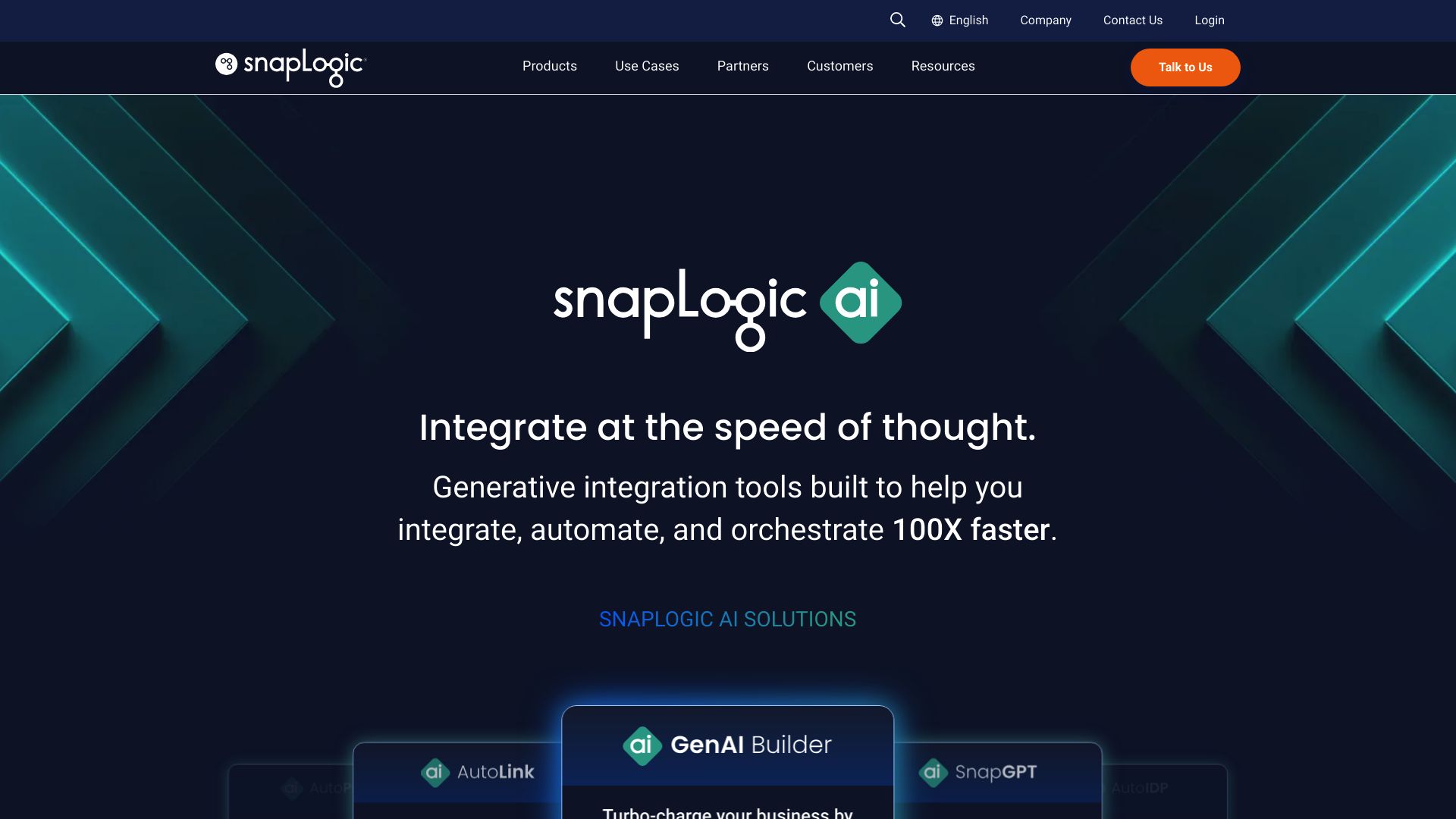snapLogic AI vs. Torq Hyperautomation: Comparing AI-Driven Automation Tools
AI-driven automation revolutionizes how businesses streamline operations and enhance productivity. This comparison explores snapLogic AI vs. Torq Hyperautomation, and SmythOS, three powerful platforms reshaping the automation landscape. snapLogic AI excels in data integration, offering intuitive tools for building complex pipelines. Torq Hyperautomation specializes in security operations, providing robust threat detection and response capabilities. SmythOS stands out with its comprehensive AI agent framework, enabling rapid development and deployment of sophisticated AI solutions. We’ll examine each platform’s strengths, use cases, and unique features, empowering you to choose the ideal automation solution for your organization’s needs.
snapLogic AI Overview
snapLogic AI offers an Intelligent Integration Platform that leverages AI-powered workflows to streamline IT integration projects. The platform automates design, development, deployment, and maintenance across on-premises, cloud, and hybrid environments. SnapLogic’s user-friendly interface empowers both expert developers and citizen integrators to manage complex data and application integration tasks efficiently.


SnapLogic’s AI capabilities, including the Iris AI technology, provide intelligent recommendations for building data pipelines with high accuracy. The platform’s self-service interface features an HTML5-based design that supports a wide range of users, from business analysts to IT professionals. SnapLogic handles diverse data types and sources, including structured and unstructured data, as well as batch, real-time, and streaming data.
SnapLogic’s AI capabilities, including the Iris AI technology, provide intelligent recommendations for building data pipelines with high accuracy.
The platform uses “Snaps,” which are pre-built integration connectors, to simplify connections between SaaS and on-premises applications and data sources. SnapLogic leverages Amazon’s Elastic Compute Cloud (EC2) infrastructure, enabling scalable integration processes that can adapt to enterprise needs in both cloud and on-premises environments.
SnapLogic has recently introduced SnapGPT and GenAI Builder, tools that enable no-code development of AI applications. These innovations allow employees to create AI models and chatbots using natural language prompts, further democratizing access to AI technologies within organizations. While SnapLogic offers powerful integration capabilities, users should consider the potential learning curve associated with mastering its comprehensive feature set and ensure their specific use cases align with the platform’s strengths.
Torq Hyperautomation Overview
Torq Hyperautomation delivers an AI-driven platform for enterprise-grade security operations, enabling organizations to automate complex security processes at scale. The platform connects the entire security infrastructure stack, allowing for instant remediation of security events and orchestration of intricate security workflows.
Torq’s platform excels in customizable logic through its workflow feature, empowering security professionals to focus on strategic activities. Triggers initiate workflows based on various events, while modular steps automate specific actions. The system leverages variables for persistent data management and boasts extensive integrations with third-party services.
Torq Hyperautomation delivers an AI-driven platform for enterprise-grade security operations, enabling organizations to automate complex security processes at scale.


Key features include automated case management and flexible workspace management with role-based access control. These components work in concert to streamline security operations, enhancing overall efficiency and reducing the burden on security teams.
While Torq offers robust automation capabilities, it may present a learning curve for users unfamiliar with security operations. The platform’s focus on enterprise-grade solutions might also make it less suitable for smaller organizations with simpler security needs.
Torq’s vision centers on empowering organizations to handle security events with precision and speed.
Torq’s vision centers on empowering organizations to handle security events with precision and speed. By leveraging AI-driven hyperautomation, Torq aims to enhance overall security posture and liberate security professionals from repetitive tasks. This approach positions Torq as a forward-thinking solution in the rapidly evolving landscape of cybersecurity automation.
Feature Comparison
snapLogic AI and Torq Hyperautomation offer distinct approaches to automation, with some key differences in their core components and security features. snapLogic AI excels in data integration and transformation, providing a visual interface for building complex data pipelines across various systems. Its AI-powered recommendations streamline the creation of integration workflows, benefiting users with varying technical expertise. In contrast, Torq Hyperautomation focuses on security operations, offering AI-driven automation for threat detection and response.
While both platforms support hosted agents and multiple environments, Torq Hyperautomation’s security-centric approach provides more robust features for constrained alignment and IP control. snapLogic AI, however, offers broader support for foundation AI models and integration with services like Zapier, making it more versatile for general automation tasks. Torq’s emphasis on security workflows gives it an edge in audit logging and monitoring capabilities specifically tailored for cybersecurity needs.
Neither platform fully matches SmythOS’s comprehensive AI agent capabilities, particularly in areas like multimodal interactions, autonomous problem-solving, and advanced deployment options such as GPT integration. SmythOS offers superior flexibility in creating and managing AI agents across various use cases, from chatbots to complex decision-making systems, setting a new standard in the AI automation landscape.
Feature Comparison Table
| snapLogic AI | Torq Hyperautomation | SmythOS | |
|---|---|---|---|
| CORE FEATURES | |||
| Memory & Context | ❌ | ✅ | ✅ |
| Explainability & Transparency | ✅ | ❌ | ✅ |
| Problem-Solving Capabilities | ✅ | ❌ | ✅ |
| Human-AI Interaction | ✅ | ❌ | ✅ |
| SECURITY | |||
| COMPONENTS | |||
| Foundation AIs | ❌ | ✅ | ✅ |
| Huggingface AIs | ❌ | ❌ | ✅ |
| Zapier APIs | ❌ | ❌ | ✅ |
| All other APIs, RPA | ✅ | ❌ | ✅ |
| Classifiers | ❌ | ✅ | ✅ |
| Logic | ✅ | ❌ | ✅ |
| DEPLOYMENT OPTIONS (EMBODIMENTS) | |||
| Deploy as API | ✅ | ❌ | ✅ |
| Staging Domains | ❌ | ✅ | ✅ |
| Production Domains | ❌ | ❌ | ✅ |
| API Authentication (OAuth + Key) | ✅ | ❌ | ✅ |
| Deploy as Site Chat | ❌ | ✅ | ✅ |
| Deploy as Scheduled Agent | ✅ | ❌ | ✅ |
| Deploy as GPT | ❌ | ✅ | ✅ |
| Scalability | ✅ | ❌ | ✅ |
| DATA LAKE SUPPORT | |||
| Hosted Vector Database | ❌ | ✅ | ✅ |
| Sitemap Crawler | ❌ | ❌ | ✅ |
| YouTube Transcript Crawler | ❌ | ❌ | ✅ |
| URL Crawler | ❌ | ❌ | ✅ |
| PDF Support | ✅ | ❌ | ✅ |
Best Alternative to snapLogic AI and Torq Hyperautomation
SmythOS stands out as the superior alternative to snapLogic AI and Torq Hyperautomation, offering a comprehensive AI agent development platform that combines ease of use with powerful features. Our platform empowers users to create and deploy sophisticated AI agents across a wide range of applications, from customer service chatbots to complex decision-making systems.
Unlike snapLogic AI’s focus on data integration or Torq Hyperautomation’s security-centric approach, SmythOS provides a versatile foundation for building AI agents that can handle diverse tasks. We offer a visual builder that simplifies the creation process, making AI development accessible to users with varying levels of technical expertise. This democratization of AI technology allows businesses to innovate rapidly and efficiently.
SmythOS excels in its feature set, offering capabilities that surpass both snapLogic AI and Torq Hyperautomation. Our platform supports multimodal interactions, allowing AI agents to process and respond to various input types…
SmythOS excels in its feature set, offering capabilities that surpass both snapLogic AI and Torq Hyperautomation. Our platform supports multimodal interactions, allowing AI agents to process and respond to various input types, including text, voice, and images. This versatility enables the creation of more sophisticated and user-friendly AI solutions. Additionally, SmythOS provides robust memory and context management, ensuring that AI agents can maintain coherent, context-aware interactions over time.
One of the key advantages of SmythOS is its flexibility in deployment options. Users can deploy AI agents as APIs, webhooks, site chats, or even integrate them with popular platforms like GPT. This flexibility, combined with our scalable infrastructure, allows businesses to seamlessly incorporate AI agents into their existing workflows and systems. Whether you’re a small startup or a large enterprise, SmythOS adapts to your needs, providing a future-proof solution for AI development and deployment.
In summary, SmythOS offers the best of both worlds — the comprehensive integration capabilities of snapLogic AI and the security focus of Torq Hyperautomation — while providing a more user-friendly, versatile, and powerful platform for AI agent development. Our commitment to innovation and ease of use makes SmythOS the ideal choice for businesses looking to leverage AI technology effectively and efficiently.
Conclusion
snapLogic AI and Torq Hyperautomation offer powerful automation solutions for different use cases. snapLogic AI excels in data integration and transformation, providing an intuitive visual interface for building complex data pipelines. Its AI-powered recommendations streamline workflow creation, making it accessible to users with varying technical expertise. Torq Hyperautomation, on the other hand, focuses on security operations, offering robust AI-driven automation for threat detection and response.
While both platforms have their strengths, neither fully matches the comprehensive AI agent capabilities of SmythOS. Our platform stands out with its advanced features like multimodal interactions, autonomous problem-solving, and flexible deployment options. SmythOS offers superior flexibility in creating and managing AI agents across various use cases, from chatbots to complex decision-making systems.
SmythOS sets a new standard in the AI automation landscape with its drag-and-drop interface, extensive integration ecosystem, and versatile deployment options. We empower users to create and deploy AI agents 99% faster, making advanced AI functionalities accessible to a broader audience. Our platform supports multi-agent orchestration, enabling teams of AI agents to collaborate on complex tasks, enhancing efficiency and scalability.
Experience the future of AI automation with SmythOS. Create a free account today and start building your own AI agents with our intuitive platform. For those seeking inspiration, explore our diverse range of AI-powered agent templates to jumpstart your projects. Ready to transform your workflow? Deploy AI agents seamlessly across multiple channels and unlock limitless AI integrations with SmythOS. Join us in revolutionizing how businesses harness the power of AI.
Last updated:
Disclaimer: The information presented in this article is for general informational purposes only and is provided as is. While we strive to keep the content up-to-date and accurate, we make no representations or warranties of any kind, express or implied, about the completeness, accuracy, reliability, suitability, or availability of the information contained in this article.
Any reliance you place on such information is strictly at your own risk. We reserve the right to make additions, deletions, or modifications to the contents of this article at any time without prior notice.
In no event will we be liable for any loss or damage including without limitation, indirect or consequential loss or damage, or any loss or damage whatsoever arising from loss of data, profits, or any other loss not specified herein arising out of, or in connection with, the use of this article.
Despite our best efforts, this article may contain oversights, errors, or omissions. If you notice any inaccuracies or have concerns about the content, please report them through our content feedback form. Your input helps us maintain the quality and reliability of our information.
